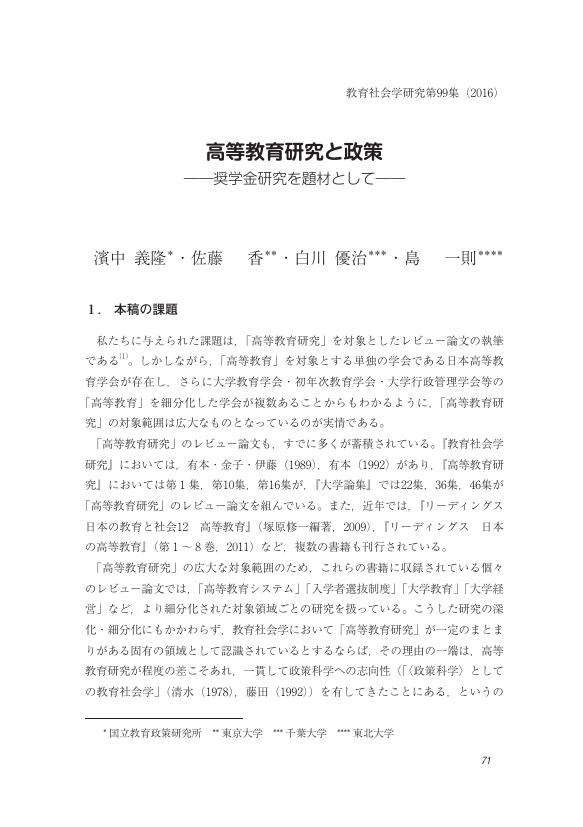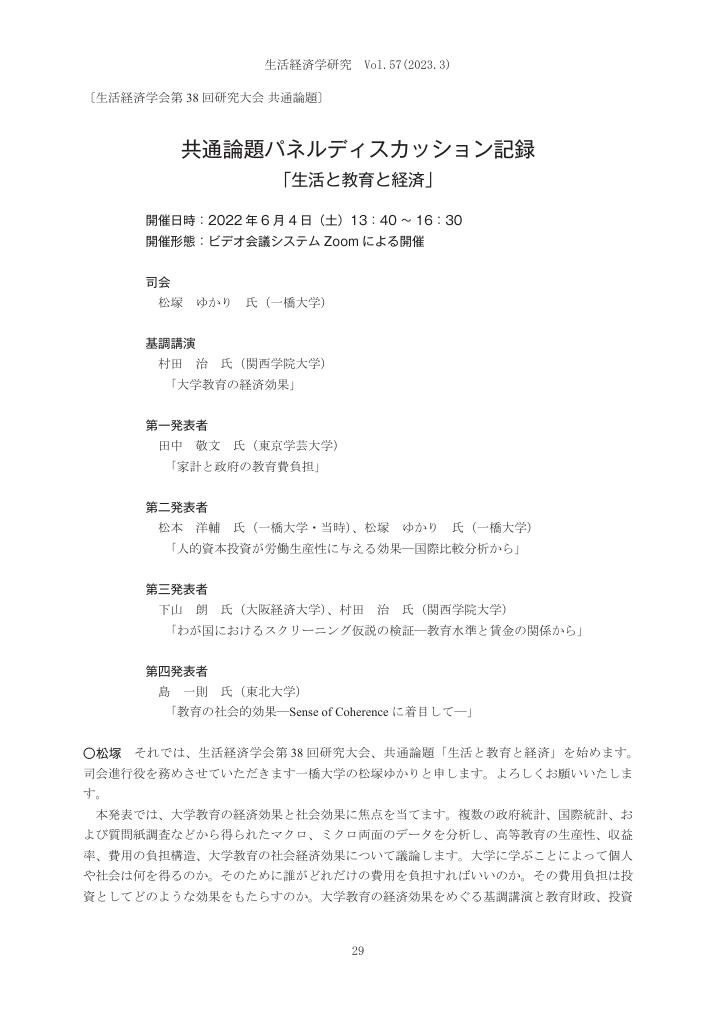89 0 0 0 OA 大卒・大学院卒者の所得関数分析 —大学教育経験・学習有効性認識・自己学習投資に注目して—
- 著者
- 島 一則 藤村 正司
- 出版者
- 国立大学法人 東京大学大学院教育学研究科 大学経営・政策コース
- 雑誌
- 大学経営政策研究 (ISSN:21859701)
- 巻号頁・発行日
- vol.4, pp.23-36, 2014 (Released:2022-04-28)
- 参考文献数
- 24
- 被引用文献数
- 1
In this paper, we demonstrate that graduate students received higher salaries than undergraduates in Japan, using a large data sample. In addition, we show that graduate students have a more successful university educational experience, assess the validity of university education higher, and invest in self-learning after graduation from university or graduate school more than undergraduate students. Further, we indicate that successful university educational experience, assessing the validity of university education higher, and investing in self-learning aftergraduation partially contribute to raising their earnings.
12 0 0 0 OA 日本学生支援機構貸与型奨学金の受給が生活時間に与える影響 ―傾向スコアマッチングによる検証―
- 著者
- 呉 書雅 島 一則 西村 君平
- 出版者
- 日本高等教育学会
- 雑誌
- 高等教育研究 (ISSN:24342343)
- 巻号頁・発行日
- vol.22, pp.207-229, 2019-05-31 (Released:2020-06-03)
- 参考文献数
- 46
長らく奨学金が社会問題化している.奨学金を批判する報道が繰り広げられ,学術的な文脈でも,奨学金が若年層の貧困化などの原因と論評されている.しかし,少数の事例に関する報道や政府統計に基づく簡易的な統計分析,さらには未返済の側面のみに集中して,脆弱なエビデンスに依拠して奨学金政策そのものを退ける論調には疑義を挟まざるを得ない.そこで,本研究では,生活時間に着目し,奨学金政策が大学生活に与える影響を傾向スコアマッチングで検証する.分析の結果,国公私立大学を問わず,奨学金によって学習活動時間が増加していること,偏差値45未満の私立大学の学部でも学習活動に正の影響を与えていることが明らかになり,奨学金の返還に関わる一部の事例をもって奨学金政策全体を非難する言説に対する反証が得られた.
4 0 0 0 OA 高等教育研究と政策
- 著者
- 島 一則
- 出版者
- 日本教育行政学会
- 雑誌
- 日本教育行政学会年報 (ISSN:09198393)
- 巻号頁・発行日
- vol.44, pp.27-61, 2018 (Released:2019-09-20)
- 参考文献数
- 14
- 被引用文献数
- 1
The purpose of this paper is to : ⑴ identify the “Standards” at the national level in the Basic Plan for Promoting Education ; ⑵ clarifying changes of the “Standards” at the national level from the 1st term to 3rd terms of the Basic Plan for Promoting Education ; and ⑶ comparing the standards between elementary / secondary education levels and post-secondary education level, to identify the advantages and disadvantages of the “Standards” at the national level in the Basic Plan for Promoting Education.The Basic Plan for Promoting Education (2008-2012, 2013-2017, 2018-2022) are used as text data, applying the text mining approach. The research results are summarized as follows. ⑴ Section 3 clarifies that there are three types of the “Standards” at the national level in the Basic Plan for Promoting Education (“Law” type, “Guide line” type, and “Index type”) Next identified are the “Index” type of “Standards” at the national level, which represents the national goals of education in a numerical manner, as research objects for section 5 & 6. ⑵ There were huge changes in “Index” type of “Standards” at the national level in both quantitative and qualitative ways from 2008-2012 to 2013-2017, and also 2013-2017 to 2018-2022. ⑶ The “Index” type of “Standards” at the national level were introduced to the Basic Plan for Promoting Education a bit further into elementary / secondary education levels than the post-secondary education level.The “Index” type of “Standards” at the national level may have advantages for promoting some national goals of education, for example the student test scores. At the same time, they have numerous problems : ⑴ inadequate definition of the index problem, ⑵ unstable index problem, ⑶ vague responsible actor problem for index, ⑷ legal compatibility of index, ⑸ integrity among indices, ⑹ validity and reliability of the index, and ⑺ data and statistics for the index.Even though there are many problems in terms of “Standards” at the national level, educational administration research must face and overcome these problems in order to improve the quality of education.
3 0 0 0 IR 教育・学習の経済・社会的効果に関する規定要因の連関構造分析 : 汎用的能力に注目して
- 著者
- 島 一則
- 出版者
- 筑波大学大学研究センター
- 雑誌
- 大学研究 (ISSN:09160264)
- 巻号頁・発行日
- no.41, pp.41-51, 2015-03
3 0 0 0 OA 高等教育グランドデザイン策定のための基礎的調査分析
- 著者
- 金子 元久 矢野 眞和 小林 雅之 藤村 正司 小方 直幸 山本 清 濱中 淳子 阿曽沼 明裕 矢野 眞和 小林 雅之 濱中 淳子 小方 直幸 濱中 義隆 大多和 直樹 阿曽沼 明裕 両角 亜希子 佐藤 香 島 一則 橋本 鉱市 苑 復傑 藤墳 智一 藤原 正司 伊藤 彰浩 米澤 彰純 浦田 広朗 加藤 毅 吉川 裕美子 中村 高康 山本 清
- 出版者
- 東京大学
- 雑誌
- 学術創成研究費
- 巻号頁・発行日
- 2005
本研究は、1)日本の高等教育についての基礎的なデータを大規模調査によって蓄積し、その分析をおこない、2)それをもとに各国の高等教育との比較分析を行うとともに、3)その基礎にたって、日本の高等教育の課題を明らかにすること、を目的とした。とくに大規模調査については、(1)高校生調査(高校3年生4000人を、その後5年間にわたり追跡)、(2)大学生調査(127大学、約4万8千人の大学生について学習行動を調査)、(3)社会人調査(9千事業所、2万5千人に大学教育の経験、評価を調査)、(4)大学教員調査(回答者数約5千人)、(5)大学職員調査(回答者数、約6千人)、を行い、それをデータベース化した。
1 0 0 0 OA 生活と教育と経済
1 0 0 0 OA 教育投資収益率研究の現状と課題 —海外・国内の先行研究の比較から—
- 著者
- 島 一則
- 出版者
- 国立大学法人 東京大学大学院教育学研究科 大学経営・政策コース
- 雑誌
- 大学経営政策研究 (ISSN:21859701)
- 巻号頁・発行日
- vol.3, pp.15-35, 2013 (Released:2022-04-28)
- 参考文献数
- 90
- 被引用文献数
- 1
In this paper, I will show the purpose (Section 1) and structure (Section 2) of this paper. And I will briefly introduce the human capital theory and signaling theory (Section 3). Then, I will overview the developments of rate of return to schooling studies done by researchers of foreign countries, especially in the United States and the United Kingdom (Section 4). Next I will summarize the rate of return to schooling studies done by Japanese researchers (Section 5). Finally I will compare both of them and clarify the significance and future challenges of such studies by Japanese researchers (Section 6).Section 4 demonstrates that rate of return studies by foreign researchers were especially focused on the net rate of return to schooling with ability data, twin data and IV estimates, excluding the ability and selection biases. Section 5 explains that Japanese researchers focused on the very detailed economic structure of academic credentialism, while paying insufficient attention to net rate of return to schooling. They also calculated very sophisticated estimates of rate of return to schooling by sizes and industries of companies, or to individual universities or schools.I conclude that the above sophisticated estimates of rate of return by Japanese researchers are unique and calculated based on the social concern on “ Examination Hell”. Future challenges must devote more attentions to ability biases, and also focus on the detailed economic structure of academic credentialism.
1 0 0 0 蹲踞位作業による総腓骨神経麻痺の1例
- 著者
- 島 一則
- 出版者
- 東洋館
- 雑誌
- 教育社会学研究 (ISSN:03873145)
- 巻号頁・発行日
- no.59, pp.127-143, 1996-10
The purpose of this paper is to examine whether the university decentralization policy has influenced variations in the percentage of applicants for admission to universities between prefectures and to suggest the policy implication of the reconsideration of the policy which is being argued now. In the second section I investigate the articles which were concerned with the effect of the policy of correction of the variations in application rates. In the third section I analyze the time series change of the variations in acceptance and application rates between prefectures. And in the fourth section I make a regression analysis to examine the effect of the policy of correction of the variations in application rates. To conclude, the university decentralization policy has influenced the variation in application rates. But the university decentralization and the correction of variation in application rates have not progressed or retreated since 1986 because the policy has been weakened. If the university decentralization policy is removed, it is expected that the variations in application rates will expand. So I think that the reconsideration of the university decentralization policy should be argued fully from various view points.

